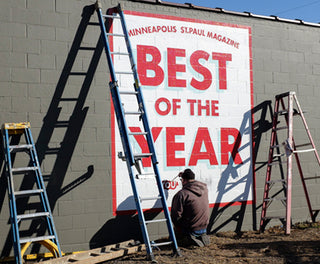Straightforward. Straight shooter. Humbled. Lost Art. Apprenticeship. Paying dues. The long game. Respect. Hard-working. Relatable…
All are descriptors that would easily and effectively help flesh out an extremely accurate tale about Minnesota sign painter Forrest Wozniak, and the way he not only carries himself, but the way he approaches his art and business. It wasn’t until I met with Forrest on the site of his painting for MPLS/St.Paul Magazine‘s “Best Of” issue (he painted the cover) and we began discussing some of his favorite signs – that I realized how ubiquitous he’s become in the metro area. To say he’s having a moment would definitely be obvious, too, as he had an installation-focused show up at Familia Skateshop, had just done the art for a custom 3D Skateboards project, and was busy painting what would be the cover of a magazine alongside all his regular commitments. Despite his hectic schedule, Forrest still took some time out of his day to share some words with me in his South Minneapolis store front studio.
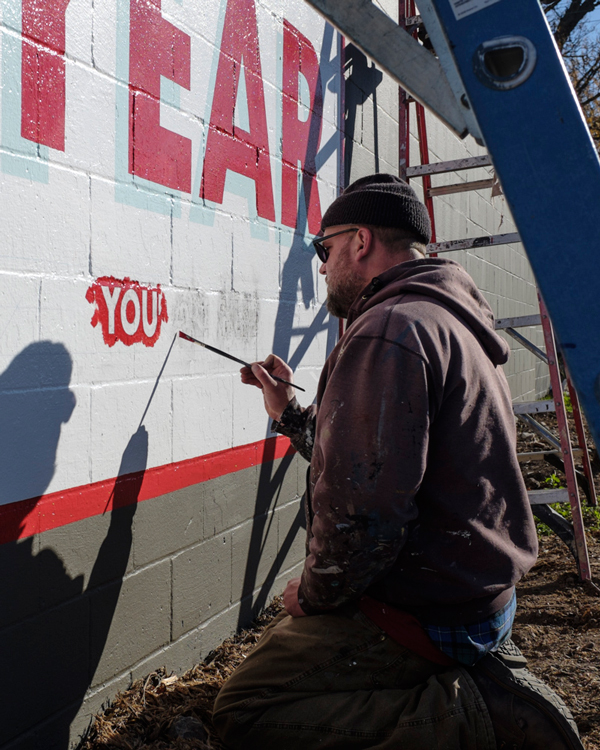
TUCKER: Do you have a season?
FORREST: yeah. My biggest month is October.
Especially in a state like MN. It’s supposed to be cold, rainy. Why signs this time of year?
This is peak season. Well, a couple things. One is that they realize what they have and haven’t done and should have done. A year-end assessment.
And you have to spend the money before year’s end for budgets. Can’t tax what you don’t have.
Yes. Exactly. Marketing expenses.
Does it drop off in the winter? Like when it’s hella cold?
Yeah, sorta. But then it’s people contacting you for the following year. Your’e still working with the politics of it all. Sign painting is not as prolific as it used to be. It’s gaining popularity and trend. That’s cool, but –
“WE HAVE A HUGE RESPONSIBILITY BECAUSE WE ARE THE LAST OF THE DINOSAURS. WE ARE THE ANCESTRAL BEGINNINGS OF ADVERTISING.”
It’s still arguably outdated because of its time intensity.
Yeah. And if you look at what our entire generation pursued, it wasn’t the trades or the vocations or architectural drafting – anything that lends itself to the physical doing. What they did was go get design degrees. Think about how many designers there are versus painters. So, it kind of can’t be prolific for the reason that you have to go through so many politics. City permits, things that never existed before. You used to be able to go up to a building, go up to a surface, not worry about size, look at he exact architecture of the building. Draft it right there, paint it, move on. It was cheaper for the client and quicker for the sign painter. Now there’s digital mockups for the clients. I outsource that service ’cause my talent is a very archaic one. Then I wait for the [client’s] response. Then when I get their response, then I send it to the city to get approved. Then I pay the $200-700 for the permit to physically do it. Those deliberations can take almost a season anyways.
Damn.
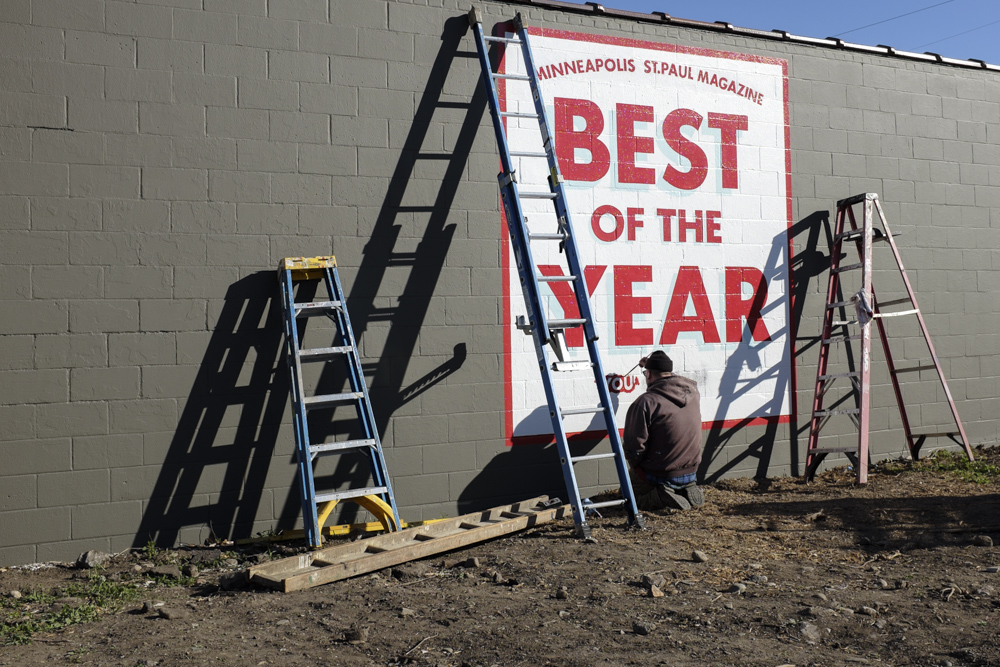
To your point earlier about the amount of illustrators, designers – they fan out on this kind of stuff, sign painting. And not knocking their talents, but can they do it? Can they do the actual painting?
It’s funny because, I’m starting to figure out how to work with that, like, with Art Directors. In a positive way. Like for the MPLS/St.Paul Magazine cover was a good example. The art director approached me and it was a rush order. I wanted to be confident of my approach and not nakedly creative. Since it’s the front of a magazine. I wanted it to compliment their aesthetic.
So I told her, “Why don’t you send me a layout that doesn’t have to be a vector file. Just a composition that you see this being and I’ll do a hand-drafted response to that composition. See how this lends itself to the brush.” I’m not married to size. Not married to fonts. I feel confident moving forward. That’s one of the techniques I’ve been using to make it easier on everyone.
It’s funny, me and Dan painted Spyhouse. That’s vector files. And large format printing. I could have just climbed up there and painted the thing. They’re going for an industrial vibe – you could have saved the designer fee probably.
“Just tell me what you want!”
If you’re going for that utility/working class/industrial vibe, I got you.
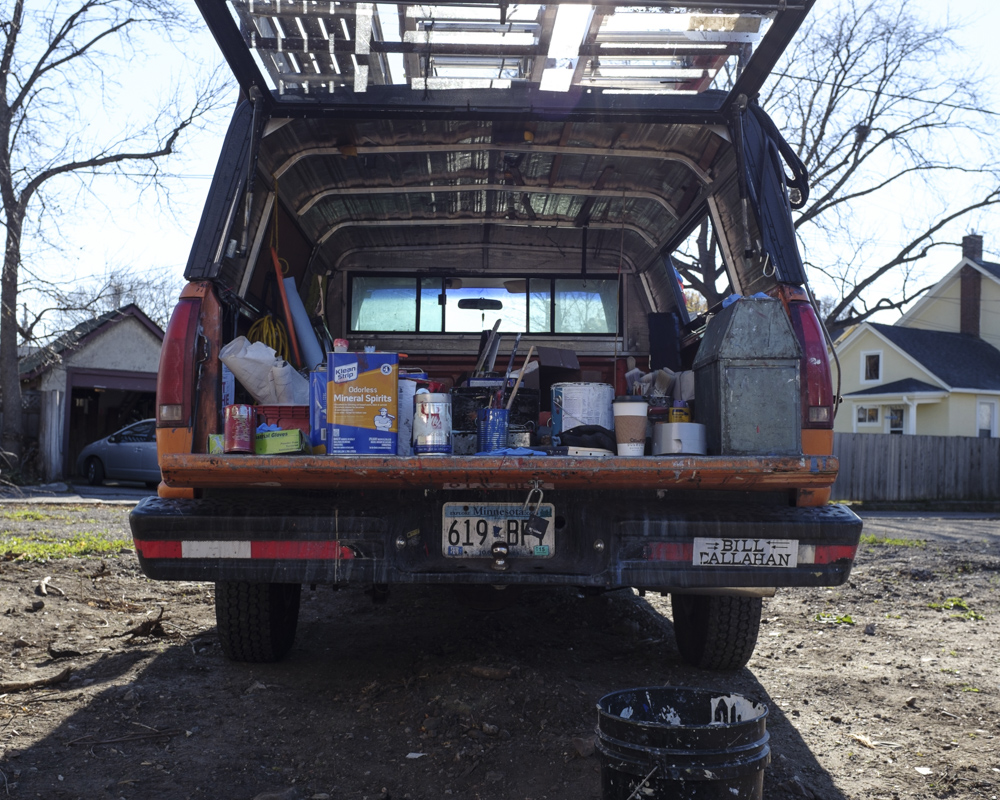
“WHAT DOES THAT MEAN TO SUPPORT LITTLE PEOPLE? SOMETIMES YOU TAKE A HIT. SOMETIMES YOU WORK FOR SHOES… IF YOU WANTED TO MAKE MONEY, THERE’S OTHER JOBS.”
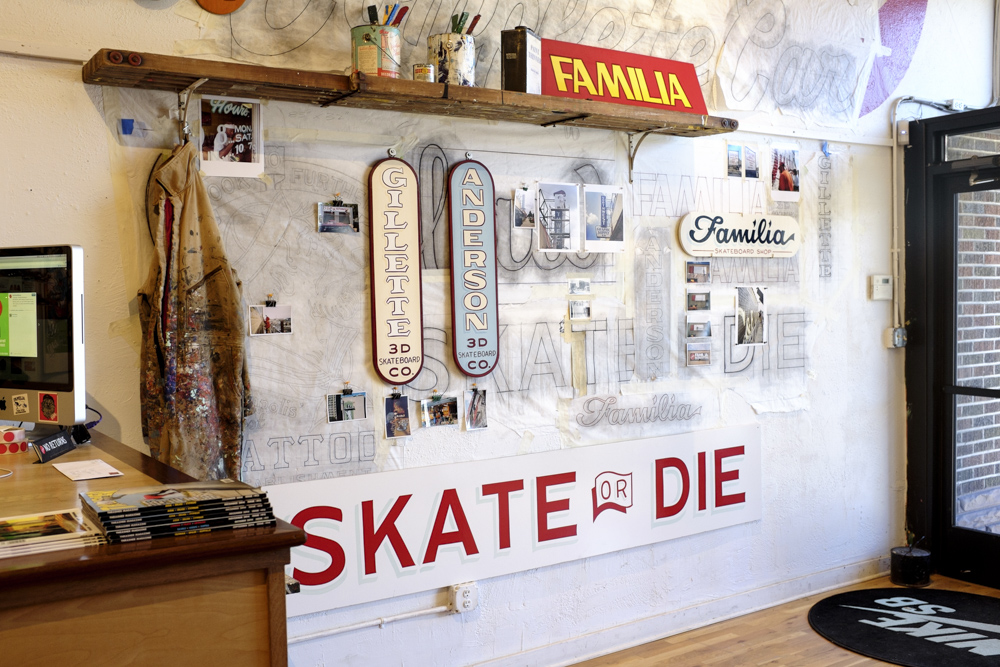
So how long you been doing this?
I started in the late ’90s. With some contemporaries of mine that have moved on to be relatively well known as sign painters.
All from here?
We all converged here. Sean went on to be everywhere. LA, Pittsburg, Seattle now. Ira went back to Olympia. Sven went to Sweden. We were doing more, like, found object art? Like, that classic early 2000s stuff.
Like Margaret Kilgallen kinda stuff?
Well, yeah kinda. Take a toxic paint and paint the Virgin Mary with one eyeball on a rusty sign or something.
Yeah, very much of the times.
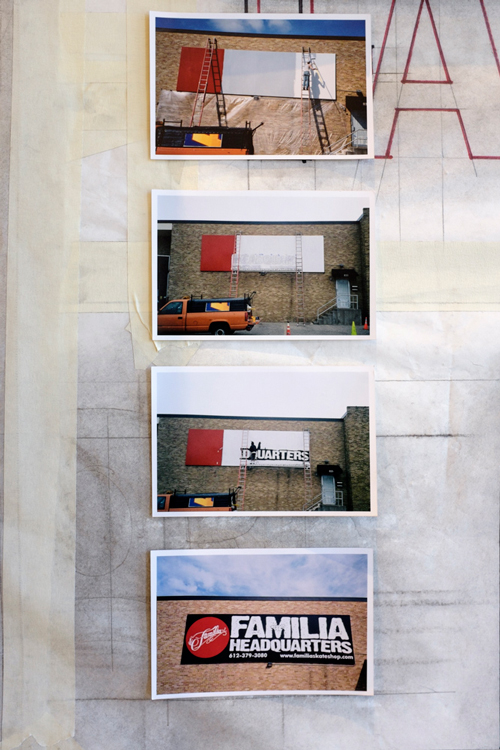
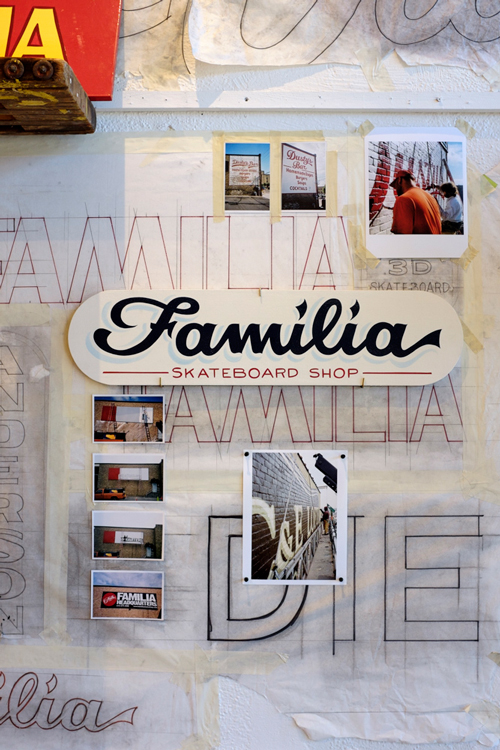
There’s a certain naivety to it.
Then I was traveling with a punk rock band. I established a pretty close relationship with Ira Coyne. When we toured the West Coast, I just stayed in Olympia. And Olympia is kinda like Fast Times at Ridgemont High, permanently. It was a cool platform for a sign painter. You just walk up to whatever cool, young place or young business owner and say, “I’m gonna paint this for you.” Ira was a little more established. I was painting his pictorials. He’d paint a bookstore and I’d paint a stack of books. So that gave me a little confidence. Over the years I’d hit the road. I’d go to Albuquerque to visit buddies, pick up a ’53 Plymouth Cranbrook thinking it had some resale value. Start driving across the country, thinking hopefully I’ll meet up with my girlfriend in Nevada. This is pre-cell phones! You’ve got a lover that’s like, “Meet me in Gerlach, Nevada, May 9th.” I’m like, “I gotta be there!”
“IT’S NOT LIKE YOU WERE A HACK, ‘CAUSE YOU WERE EARNEST.”
Ha. “I’m committed to this!” Oh man.
I’d bring a little kit.’ Cause all of a sudden I started romancing about how this could be a vocation. You could have this [starts pointing to brushes and tools], a couple of these, some jars of primaries and some white. Like, the size of a tackle box. You could wrap it up in a ziplock. You could really travel and be somewhat viable. A pint of paint can get you across a few states if you’re doing window lettering.
So, windows were the first applications for you?
Yeah. It was cool. For instance, I’d be in Wyoming – people were really responsive there. I could walk up to a book store with no sign at all. So it’s not that they’re really critical. They weren’t like, “I know fundamental sign painting and you’re a hack.”
Yeah, like, “This doesn’t look like this other sign I paid for looks like.”
It’s not like you were a hack, ’cause you were earnest. I wasn’t claiming anything. I would just charge what a hotel room in a small town room costs, six pack of tall boys and a tank of gas would cost. It was a good way to sharpen my teeth. You didn’t have that contemporary influence either. That peer influence. That can be really intimidating to be around them. If you’re really testosterone-driven, though, it can be really beneficial.
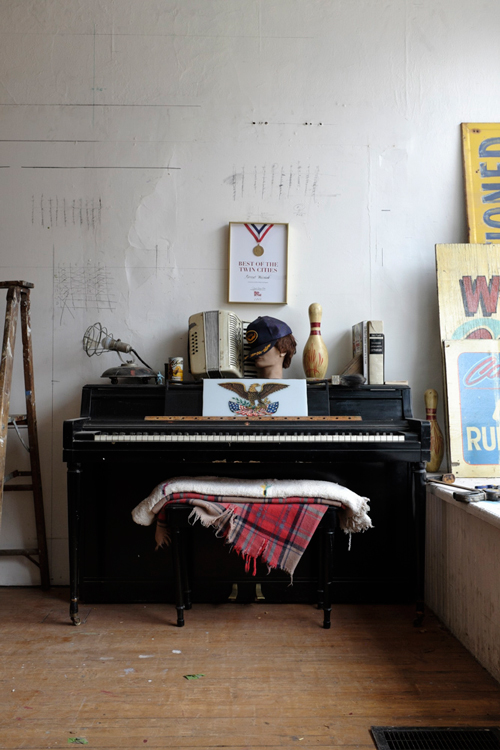
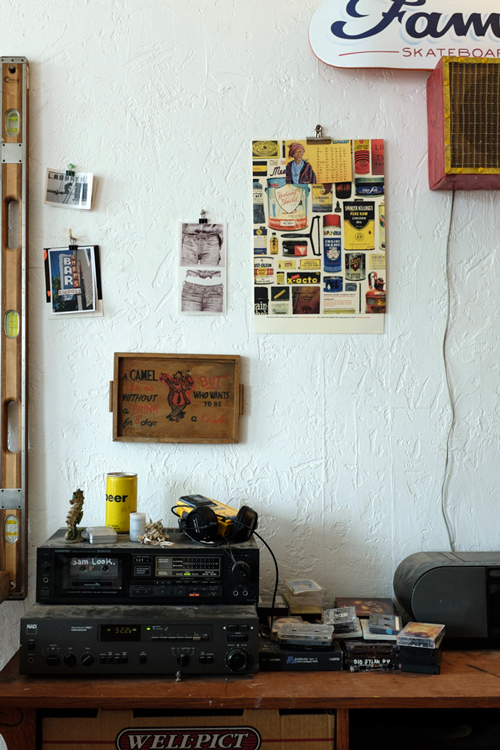
So when did you move back to MPLS after all this roaming?
After all the roaming, I really started settling down in MPLS back in 2003, 2004. These are hyper-exaggerated experiences we’re talking about here – in the span of a few years. That time was so developmental. That period of 19 to 23 [years old], you’re riding freight trains, driving hoop-dees, you know what I mean? Like, on the road – the real deal. All of a sudden, you become this viable service and you could still be a road dog. Like a road dog with class.
Did you come back to town and find it fairly easy to get work?
Yeah. ‘Cause I knew a lot of people since I’m from South MPLS. I still wasn’t any good though. I was terrible. I didn’t know what to look for. I didn’t know how to measure. What to measure. I didn’t know how to draft. And I still work on that. In some ways, I can critique my sign better than I could repair it. I can figure out what I did wrong better than what I did right ’cause I’m still learning. So I started painting signs for friends of mine that were beginning to own businesses. Then I approached, because I was lucky enough to pick up on that old school class of where, like you respect those that come before you; be good to your elders.
“I FEEL A LOT OF SIGN PAINTERS THINK IT’S VERY LABORATORY/INDOORS… I’M LIKE, ‘PUT ME IN THE DUST. THE RAIN.'”
Like the old school apprenticeship model?
So I approached this old-timer Phil Vandervaart cause I got a sign gig. A friend of mine took over ownership of this place that Phil had done the sign for in the ’90s. He had done this ’90s pastel terrible hippy sign. I redid the sign and then they wanted more work. And that was my cue to invite Phil in. And be like, “Look, I’ve got this big enough contract, want in?” And we kinda had some rapport over the years. He was the aesthetic face of the West Bank. Through the ’80s and ’90s, that whole bohemian aesthetic was really his. That was very much him. And there’s not a whole lot of evidence left. I mean, there’s Hard Times. At one point though that whole landscape was really plastered in his lettering.
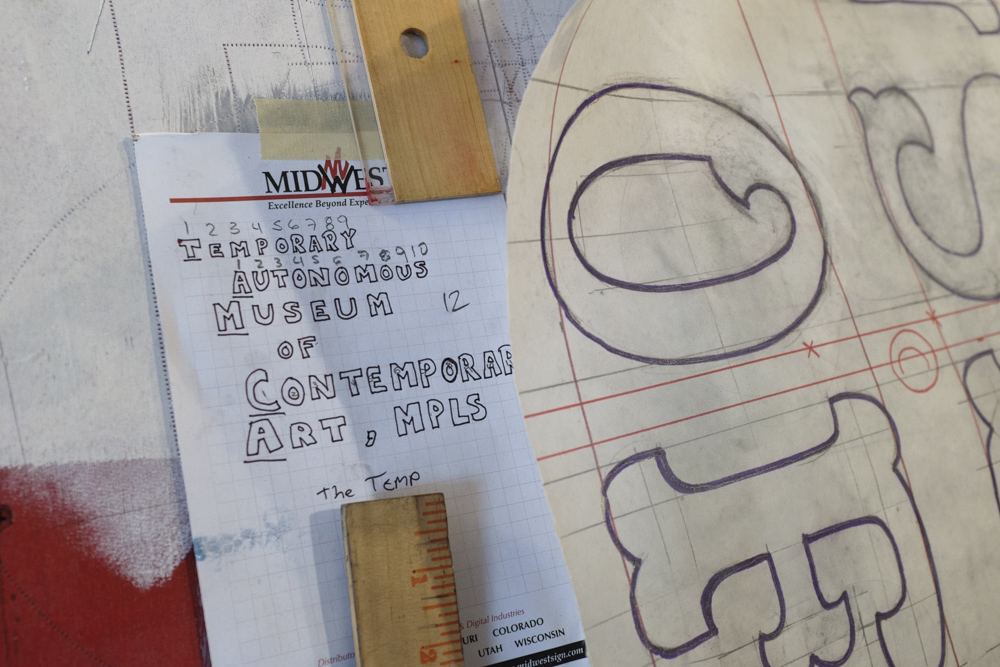
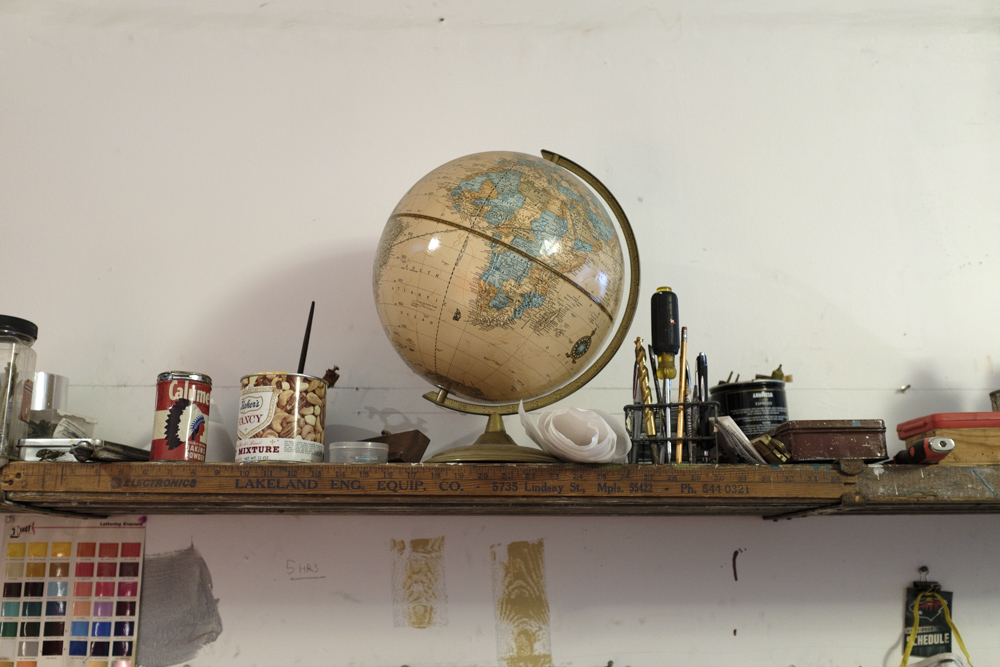
Like that guy Pucchi guy that took over. He basically owned Uptown for a time.
Totally. And it really bothered me for a time. But now I really cherish the ones I see around. Now the few that survived I’m like, “God, I really like those.”
He was everywhere.
Then Phil told me I had to paint over the sandwich board at May Day ’cause it was so ugly. We did a whole big once-over for them. Me, Phil, and Sven – who ultimately went on to become a famous American pinstriper. Hotrod culture [there] is like the equivalent to rap or skateboards here. If you’re cool and hip and know what’s going on, you’re wearing Levi’s and white tees. That’s what’s going on there.
We all found our angles. I feel like I found mine, which was walls. Big. That’s where I really feel comfortable. When I’m doing [projects like making sign for that museum], I really like it. It’s fun. I’m enjoying myself ’cause I’ve gotten into the drafting and coming up with a letter without looking at a book. But when I feel like I have something to offer where other people can’t, I feel like my strength is on the big walls.
Scale and stuff.
Scaffolding. Because of my background in construction, I have the ability to capture a large space. I feel that’s my strong suit. There’s a lot of different views about it all, but I feel a lot of sign painters think it’s very laboratory/indoors... like if they’re were a surgeon. Dust-free. You know what I mean? I’m like, “Put me in the dust. The rain.”
Like, “Take me back home.”
Real Minnesotan sign painter.
So I worked with Phil, and still do to this day. The next 10 years, every single sign had something to do with him. I’d design it enough to pitch it to the client, create that trust with the client to proceed, and then it was like bring it to the oracle in the cave. Bring it to the old man. He’d be smoking his dutchies and reading the New York Times. And add his timeless stroke of brilliance cause he’s probably the only living person in this town that was educated in sign painting. He’s an eccentric, very principled hippy. But he’s also a Navy veteran. He was trained during the CETA Program. It was part of the Carter administration-put out a program where you could learn a vocation for a minimum wage.
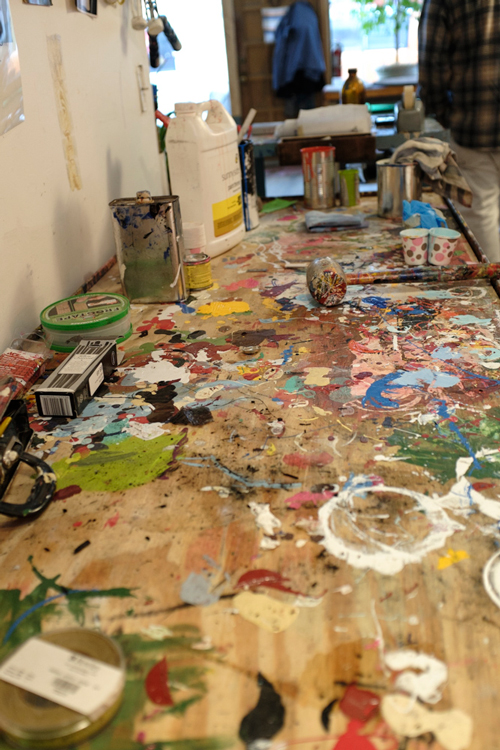
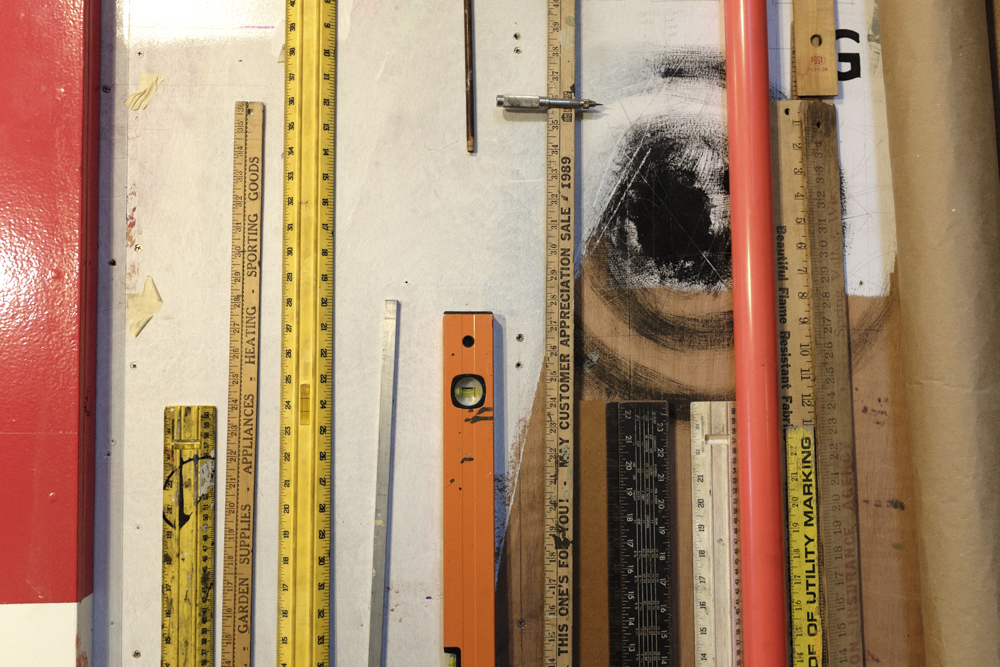
Fucking cool.
It’s way cool. And of course it got eliminated under Reagan.
Well... ha.
The guy here in MPLS, Kevin Belcher, came out of that program too. They’re both exact contemporaries from the CETA program in Chicago. And you can see their layout and composition are based on rules. Where our generation’s layout and compositions is based off flashiness.
Like, “Yeah, this would be cool, I’ll add one of these and one of those.”
Yeah. Add a sparkle. Add a swirly-Q. So that gave me what I feel was the 21st century equivalent of an education [in sign painting]. The best you can get.
The best you can get in something that’s not taught anymore, really.
Exactly.
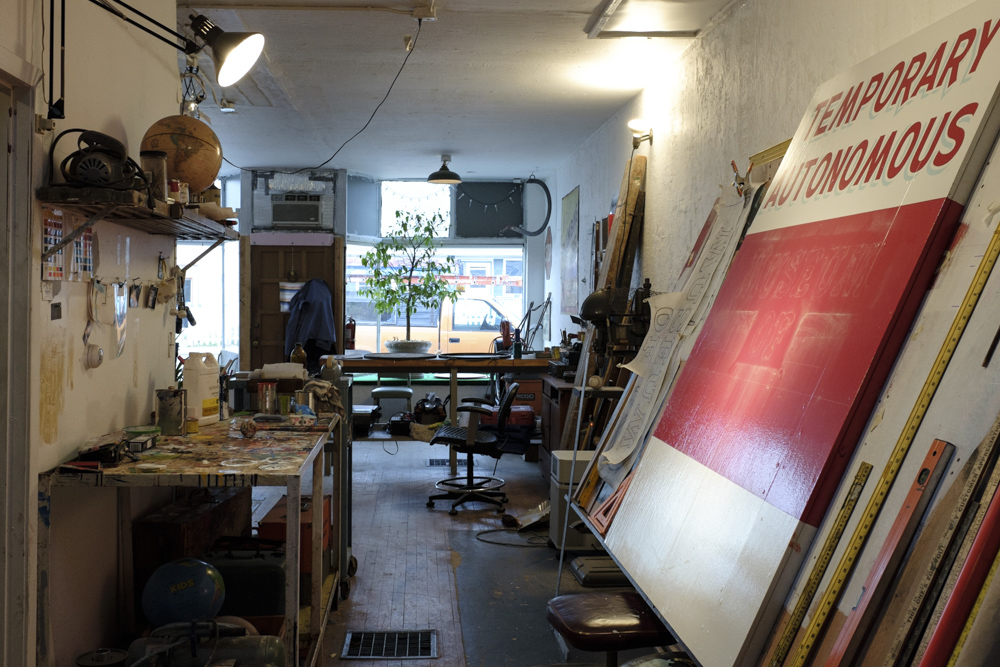
So in MPLS, with the other sign painters too, there seems like there’s enough work to go around?
Definitely. Every once and a while, I get a little egotistical about it and I want be like the mob boss and everything comes through me. But that’s not reasonable [laughs].
That’s gonna dilute your approach.
Exactly.
You might not think about it in the moment, though.
Yeah. And me, Dan [a younger sign painter that shares space with Forrest], Phil... we all have this real positive relationship. Where it’s not like we collude – we run our own businesses. But we support each other. If for some reason one of us should just run out of work or something, it’s not like all of a sudden we’d just let one of us suffer.
So have you done for other people what Phil has done for you? As far as bringing people up? Like in the that old school “I’m gonna take you under my wing” type thing? Or, do people approach you for something like that?
I get approached a lot. And I’m really receptive to the idea. I’m supportive of Dan, but he kinda established himself. He had his own trajectory already. So I work with him, more like the code of conduct, not really like painter design. Does that make sense?
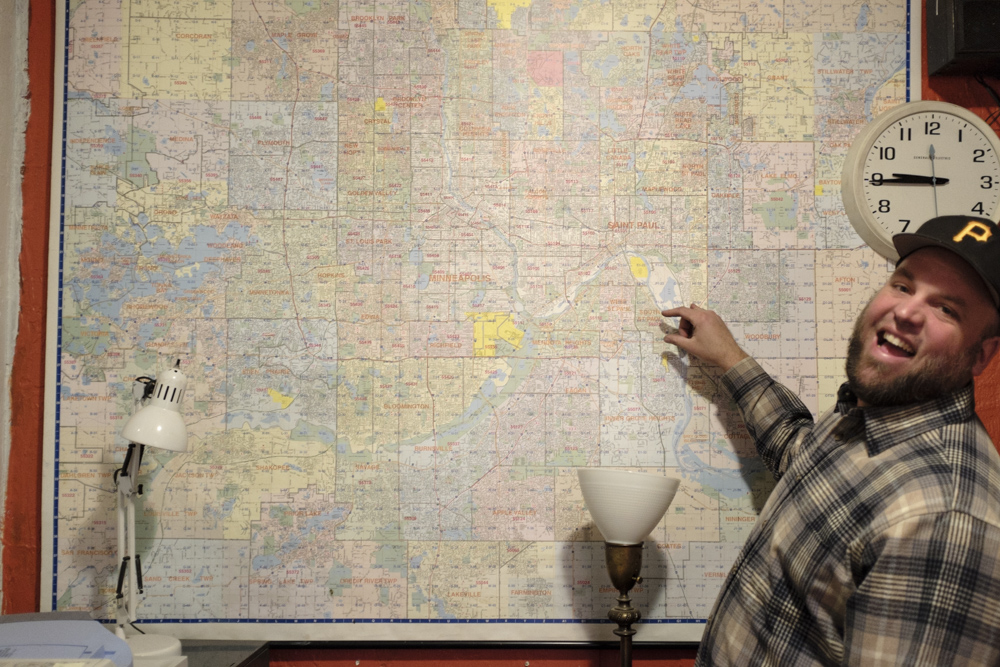
Like there’s a way to do things. Approach people. Handle yourself.
And that we have a huge responsibility because we are the last of the dinosaurs. We are the ancestral beginnings of advertising. So that’s led us to be in the position of being the anti-corporate response to free enterprise. So when you are such, you then are a proponent of free enterprise. Therefore you support small business, families, little people. What does that mean to support little people? Sometimes you take a hit. Sometimes you work for shoes. You know what I mean? This is a responsibility that eventually you have to accept. IF you wanted to make money, there’s other jobs. Do you want to be a service to mankind and make something that lives longer than you, then you are in the right vocation. If you’re in it just for the dollar, then there’s better things to be doing.
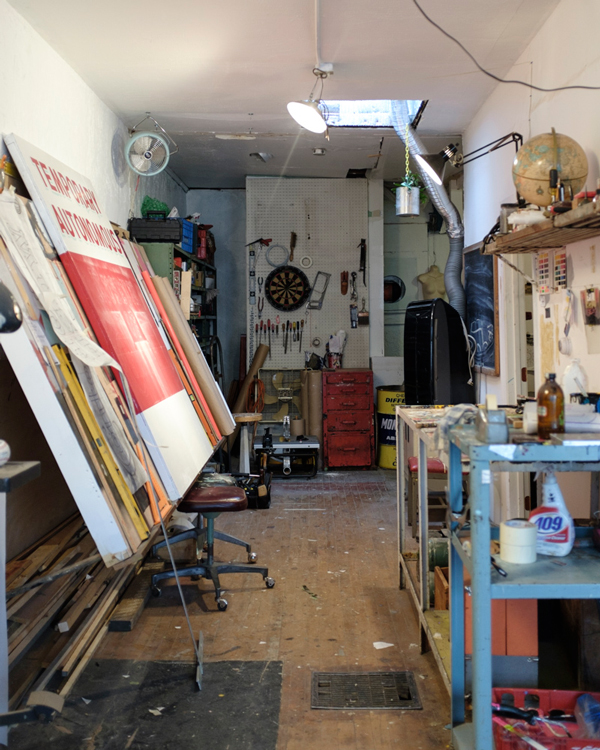
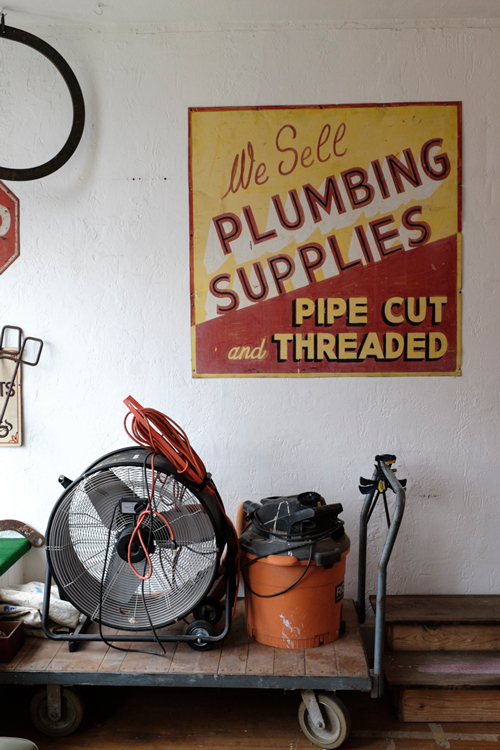
Did you just freestyle these letters here [on the museum sign]?
I did. Yeah. That’s why I wiped it out. Sometimes you don’t notice things till you’re doing them. Like, why’d I make the “e” so fat? I’m working this “e” out as I go.
Process!
I’m not religious about it. There’s definitely sign painters that you might meet – they wanna see you use a half inch brush make a half inch letter. That’s how they see sign painting. I don’t come from that school at all. I come from a sign builder with paint. Like, I have no shame in playing with it.
As long as you get there. As long as the end product is worthy.
I’ll try not to, of course, [in-sign edit] on principle. I will if it makes for a better product. ‘Cause this goes on buildings and walls. No one comes up to it and says, “This guy used the background to clean that up.” They go, “That sign looks good,” or, “It doesn’t look good.”
You gotta crack some eggs to make an omelet.
Who gives a shit.
Let’s just eat.
Yeah. Make it pretty. I’m under the rule of thumb of do it correctly versus the perfect act of doing it. I’m not making love to the sign, plus no one is witnessing me do it. Just make sure the finished product looks really choice. That’s how I come to it. A lot of people would argue and that’s their prerogative. They’ll say you’re a hack if you’re painting with the background, your letters should be the thickness of your brush, that type of shit. Whatever. They should have been a surgeon. I’m more Vaudeville-Coney Island kinda guy.
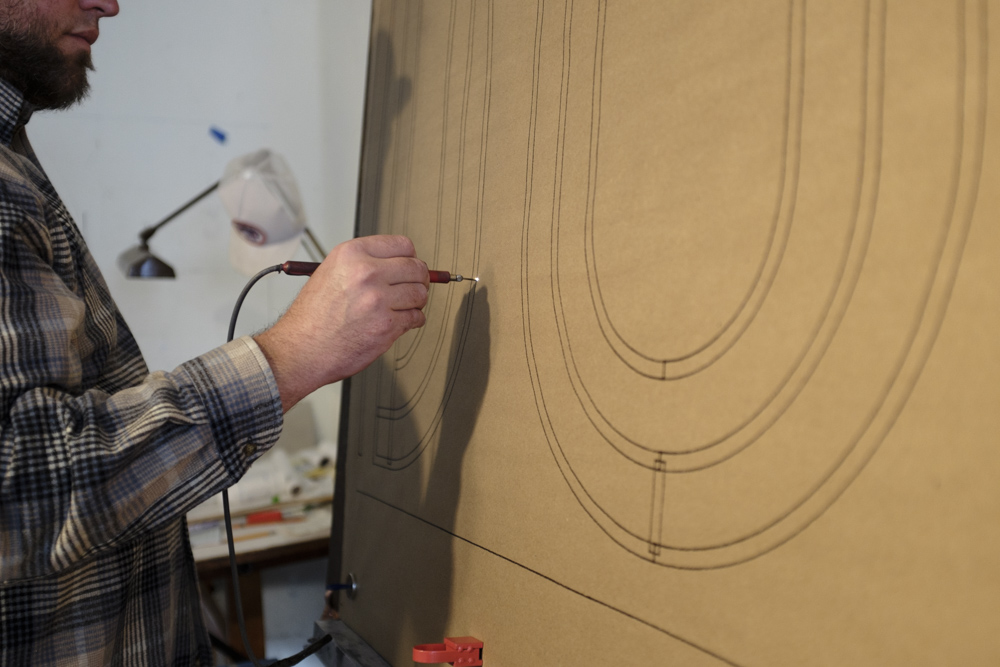
Speaking of Coney Island. Was it Stephen Powers that did that?
Yeah.
Dudes like him – are there more of your contemporaries across the country? Is there any rallying? Is there a network? Do you gotta guy in Chicago, or Nashville? I mean, you know what I’m saying here?
I think there’s somewhat of a network. I don’t know to what degree I’m a part of that network. But, for instance my buddy Sean, I think ,he’s one of the founding members of Icy Signs. Stephen Powers’ sign company. Me and Sean lived in Pittsburg together. We painted signs around the country. We lived in Bellingham, here, we’ve traveled together. We remain to this day really close friends. But a dude like Stephen, we’re loosely associated. Me and him. And in some ways, we’re definitely relatable. But he’s definitely an extension of his mission, that mission he’s had so long. Whereas I’m almost post-war, I’ve kinda got this mid-century vibe. Not on purpose, but kinda naturally because it’s just how I learned the ruler. For him, he doesn’t totally claim to be a sign painter per se, even though we all think he is. He’s an extension of his mission. He’s doing his mission. It’s been that mission the whole time, it’s grown and matured. It’s old school and he’s been working on it for a while.
Well, he comes from graffiti. In like the hey day, arguably.
Totally.
And anyone would be a liar if they claimed that didn’t totally inform their entire approach.
Absolutely. And he’s always had this sort of dominating, architectural space with his graffiti too. I remember so vividly being a teenager in high school looking at pictures of his stuff on metal grates. and he’d geometrically take over the whole cavity. You can see how he’s still the extension of that evolution.
And I don’t pay a lot of attention to the graf world much really. But I’ve been interested, I think as any artist or skate-person would be over the years. But you’re right, his art even when I think he was still considering it street art or graffiti – he’d take over a whole space. Whereas someone puts up a piece, there’s all that negative space around it. But he’d go about it like, “Ph, I have this much space? I’m gonna fill it up.” And he’d take up all 4 corners. Fill it up like a sign.
Precisely. And he’s kinda still using that style. But at his shop, he’s got old timers, old famous sign painters, sign painters. Lots of different talent there. Ultimately I think he’s still doing graffiti. And I don’t think he’d think that was an insult, I think he’d say that. I think he thinks he’s still doing it. I don’t know, we’d have to ask him. Not as an insult or compliment. That’s just what he’s doing.
I think the nature of most the messages he’s putting out into the world are still kinda awareness-driven or subtle “fuck you’s.” Or commentary on social aspects. Which is rad.
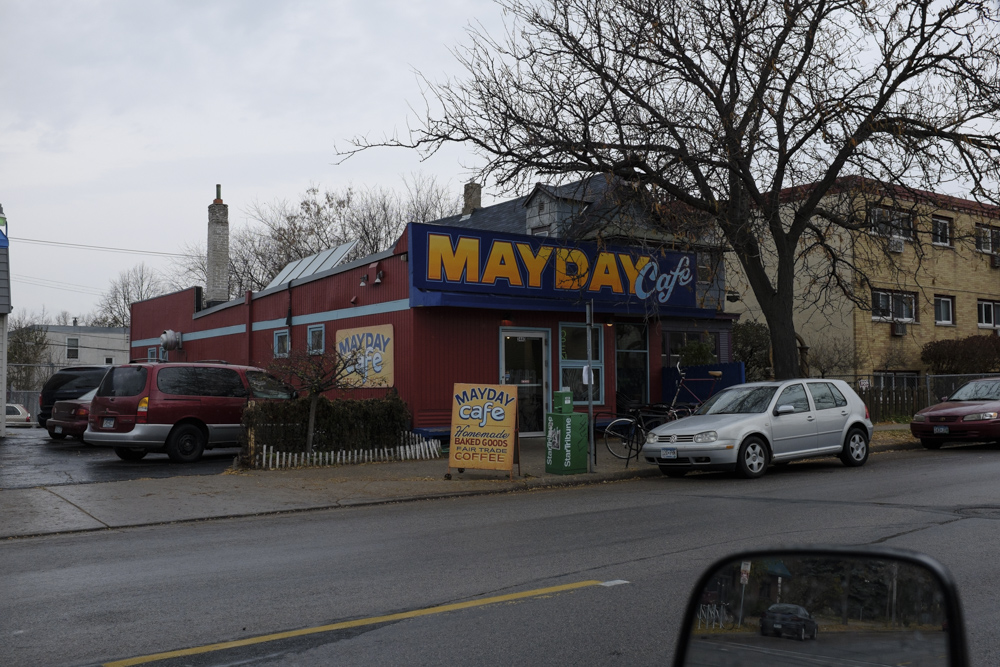
“I’D LIKE TO CAPTURE MY EDUCATION FROM PAINTING AND APPLY IT ELSEWHERE LATER IN LIFE.”
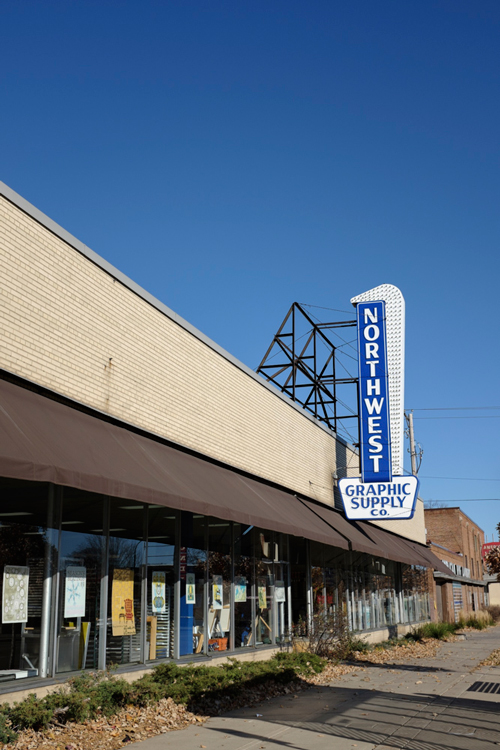
::
INSTAGRAM: @FORRESTWOZNIAK

